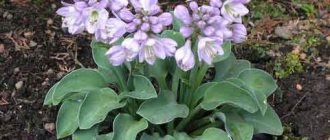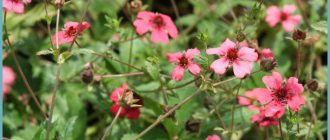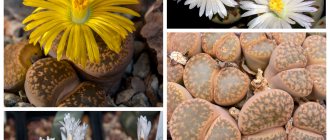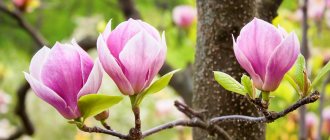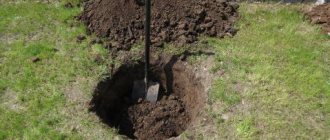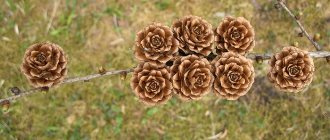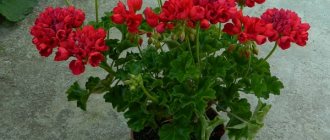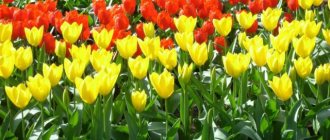Tropical perennial shrub of the Verbenaceae family. It grows and develops quickly and requires a spacious room and bulky dishes.
It reaches 3 m in length. The branches are large and covered with bark. Thorns are rarely present. The leaves are green and heart-shaped. The flowers are located on a peduncle and form a ball. They change color during the growing season, which runs from May to October.
Kinds
Only two types of lantana are bred indoors. More than 150 are known in nature.
| View | Description | Variety | Blooming period |
| Kamara (vaulted) | The stem curls and is covered with thorns. The leaves are gray-green, oval. The top is smooth or rough, the bottom is covered with pile. |
| Tubular in shape, collected in inflorescences. The color turns yellow into orange, pink into red. From the beginning of May to the end of August. |
| Montevideo (Selloviana) | Branches weave along the ground. The leaves are small, green, ovate. | None. | Small ones. Color purple, pink. The inflorescence forms a shield. From June to October. |
Camara
Biological characteristics, types and varieties
The beautiful vaulted lantana, also known as prickly lantana or camara, comes from hot, sunny and humid Brazil, but over several hundred years the tropical plant has completely adapted to the southern European subtropical climate. In Crimea and the Caucasus, it is cultivated in open ground, producing luxurious thickets of evergreen, beautifully flowering shrubs. In the temperate zone, perennial forms are possible in indoor or greenhouse cultivation, but the plant grows so quickly that even in one season it forms a lush bush strewn with flowers.
Lantana camara belongs to the Verbena family and is closely related to the legendary garden verbena flower crop. They have similar inflorescences - stuffed balls consisting of many small five-petaled tubular flowers. But if verbena has multi-colored ones, then lantana has multi-colored ones. Each flower, like a chameleon, changes color as it matures - from yellow to deep orange or purple.
At the beginning of the growing season, the skeletal shoots of the plant are herbaceous and spiny; with age, the stems become coarser and woody. Axillary shoots are soft, drooping, many hybrid forms have an ampelous shape. The leaves are oval, dark green, rough, with a distinct textured pattern of veins, and exude a pleasant aroma.
Interesting! The tropical flower is considered a weed in its homeland. It grows not only in gardens and city parks, but also in vacant lots, fields, and along roadsides. In South Africa, the crop is prohibited for cultivation; in India it is called “the planters’ curse.”
Several groups of varieties and hybrids of this exotic have become widespread in culture.
- Multicolor varieties are masters of transformation. During the flowering period, the color changes from the most delicate yellow to dark purple and violet. These include hybrids of lantana camara Lyubava, Flamingo, Tutti Frutti.
- The two-color series is represented by a tall evergreen group of plants reaching 1.5 meters in height. In open ground they are used to decorate hedges and embossed borders. There is a yellow-red lantana Compact Red, a pink-yellow Bandana Pink, and a creamy yellow Yellow Cream.
- No less attractive are the monochrome lantanas obtained by hybridization - yellow Aloha with variegated leaves, snow-white Samantha, chrome-yellow Gold, soft pink Pink.
Note! In addition to the popular lantana camara, the species L. montevidei is of interest. Its distinctive features are creeping shoots, small leaves, and a lilac-violet palette. When grown in hanging containers, it takes on an ampel shape.
Lantana: home care
Tropical lantana feels comfortable at home and does not require special care.
| Factor | Conditions |
| Location/lighting | Choose any side except north. The plant does not tolerate cold or drafts. Light-loving, can be exposed to direct rays for up to 5 hours a day, but prefers diffused light. In winter it requires additional lighting. |
| Temperature | During the rest period +5…+10 ºC. In the spring they gradually increase it, bringing it to +15…+18 ºC. During the flowering period, not lower than +20 ºC, optimally +22…+28 ºC. |
| Humidity/Watering | Feels normal at a humidity of 40-50%. It is recommended to spray the leaves daily, without getting any moisture on the flowers. A drain is placed in the pan to retain water. |
| The soil | Loose, fertile, nutritious. Lets air through. Consists of a mixture of sand, peat, turf in a ratio of 1:1:1. |
| Feeding | 2 times a month during the flowering period with complex fertilizer. |
Montevideo
Seasonal care and wintering
How to care for a plant during its hibernation and wintering? At this time, it is best to move the container with the plant to a cooler place. The temperature there should be slightly lower than usual. After a few days, lower it another couple of degrees. Having reached the mark of 10..15 degrees, it is necessary to leave the plant until spring.
You will need to water the soil periodically to prevent drying out. Spray the air around the pot as well. Observe the light regime (6-7 hours a day).
Mr. Summer resident recommends: transplant
The lantana root system develops quite quickly and requires regular replanting. Young plants - once a year, older ones - once every 2-3 years. The pot for transplanting is chosen to be roomy, wide, and deep. The bottom is covered with permeable drainage (expanded clay, pebbles).
When replanting, the roots of the flower are cleaned of old soil to obtain useful nutrients from the new one. For the substrate, mix in a ratio of 1:1:3:4: humus, sand, turf, leaf soil.
Kamara (vaulted)
Diseases and pests
| Lantana shoots are stretched out and the leaves are getting smaller. | Place the plant in a bright, sunny place. Create additional artificial lighting. |
| The edges of the leaves dry out and the tops curl. | Dry air. Spray the air and Lantana itself. Use a tray with wet pebbles or expanded clay. |
| No buds in spring. | Low illumination, large pot, wintering of the plant is disrupted. |
| The branches stretched out and the leaves faded. | Not enough nutrients. Organize fertilizing with organic matter or complex mineral fertilizer for indoor flowers. |
| Flowers and buds fall. | Check the humidity and heat in the room. Water regularly with warm, settled water. |
| The appearance of brown spots, plaque, black spots on the leaves. | The plant is affected by gray rot. Treatment consists of removing the affected parts, treating with Zineb or Horus solution, watering the flower with warm water, adding Skora or Topaz. |
| Cold and damp indoors. The leaves have turned red. | Leaf rust. Change the conditions: water less, loosen the soil. Trim the diseased plant and treat it with a fungicide. |
| Waterlogged soil. | It's cold and damp in the room. Excessive watering. Root rotting. Treatment as in the previous case. |
The plant is almost not attacked by pests - insects. But in the summer, for prevention, treat with an insecticide against sucking parasitic insects. You can use Actellik, Aktara, Fitoverm. These drugs effectively destroy whiteflies, mealybugs, spider mites, aphids and scale insects. Wipe the leaves on both sides with a damp cloth. A cockroach repellent will save you from whiteflies; treat the plant, tie it in a plastic bag, place it in a shaded place for a day, then give it a cool shower. If you find powdery plaque or cobwebs on the inner surface of the leaves, the leaves become sticky, or spots appear - use a solution of laundry soap in a ratio of 20g. per liter of water, rubbing the leaves with it.
Lantana will reciprocate your feelings and will delight you with lush blooms if you follow simple care rules.
Lantana from seeds and cuttings at home
Grow by seeds and cuttings. The second method is simpler, but the seeds produce a larger number of plants at the same time. At the same time, there is a risk that lantana will not retain the characteristics of the mother flower.
- Seeds are planted in late autumn, pre-soaked in hot water +50...+60 ºC for 2 hours. Treatment with stimulants is carried out. Planted in a mixture of peat and sand. Organize greenhouse conditions. The air temperature is maintained at +20…+22 ºC. The first shoots appear after 3-4 weeks. Then they lower it to +10…+12 ºC, increase the amount of light. After the first 2-3 leaves appear, lantana is planted in separate containers.
- Propagation by cuttings is carried out in the spring, when the plant is pruned. Select branches 10 cm long, with 3-4 leaves. Planted in porous, fertile soil. Cover with film or a glass jar. Choose a bright, warm place. After two weeks, the greenhouse begins to be ventilated a couple of hours a day. After a week they remove it completely.
Montevideo (Selloviana)
Lantana propagation
The plant can be grown from seeds or cuttings.
Cuttings
Shoots with bark that has not yet lignified are suitable for cuttings. The best time to cut them is March or June. You can root cuttings either in a light, damp substrate or in a jar of water. Trimmed shoots easily take root; this usually takes about 3 weeks. Plants obtained from cuttings can bloom in the first year.
Growing lantana from seeds
You should start sowing seeds at the end of winter; at this time they produce the fastest germination and the strongest seedlings. The substrate should be light, drained, and nutritious. Place the container in a well-lit place and maintain a temperature of at least + 20C. You need to wait about 2 weeks before the first shoots appear. After the seedlings have grown by about 10 cm, they can be planted in separate pots.
Description of the plant
Lantana Camara or Lantana spinosa were grown at home . But now, with the development of technology, many hybrids and crossed species have appeared, so it is not surprising to meet Lantana of a different variety.
Indoor Lantana grows up to fifty centimeters.
This plant became popular among flower growers due to its beautiful flowers. Before the flowers bloom, they change their color several times: at first they are yellow, later they become pink, and then burgundy.
The surface of the stems is covered with spines, the leaves are dark green in color with jagged edges. The leaves have a very interesting feature. If you rub the leaf, it will begin to release a pleasant spicy smell, which spreads very easily throughout the room.
Lantana is unpretentious, so you can easily grow it at home. Plants of this species make beautiful ornamental bushes. The flower grows very quickly, so it needs to be trimmed regularly so that new inflorescences appear.
Lantana blooms from mid-spring until September. Afterwards, she begins a period of rest until next spring. Experts recommend taking the flower out into the fresh air (in the garden or on the balcony) in spring and summer.
When the plant fades, black berries appear on the flower. They are poisonous! Therefore, the flower should be kept away from small children. In order for Lantana to bloom longer, you need to pick off faded flowers, preventing the appearance of ovaries of poisonous berries.
Gardeners grow Lantana as an annual plant for their flower beds or containers. In this case, you need to place it in sunny places; in the shade it practically does not bloom. Bright color, on the contrary, stimulates the formation of inflorescences.
Growing conditions
The plant, although light-loving, can tolerate lacy shadow. Lantana can be placed in the summer on southern, southeastern and southwestern balconies.
It is important to choose the right pot for your lantana. It’s good if it is light in color, the plant’s roots will not overheat in such a container. A ceramic pot will also be comfortable for the plant due to its breathability. However, in a ceramic container, lantana will have to be watered more often.
A light pot is preferable
The comfortable summer temperature for lantana is +20 +25 degrees; the flower loves moist air and needs spraying. For the winter, plants are brought indoors and comfortable conditions are created for the dormant period. This is an air temperature no higher than +12, dim lighting, poor watering, but non-stop spraying. Too dry indoor air weakens the plant. With the onset of spring, lantana branches are cut by a third, thereby stimulating the growth of new shoots and tillering of the plant. Cut branches can be used to propagate the flower.
The soil mixture for lantana is prepared by mixing turf soil, sand and humus in equal parts. Up to 30% of high-moor peat is added to this mixture, as it contributes to the moisture capacity of the soil.
